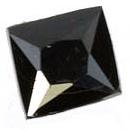|
|
||||||||||||||||
|
||||||||||||||||
|
||||||
|
|
|
|
Kaersutite
|
|
| | |
| Discovered in 1884. IMA status: Valid (pre-IMA; Grandfathered) | ||
|
| ||
|
Chemistry |
|
|
| |
|
NaCa2[(Mg;Fe2+)4Ti](Si6Al12)O22(OH)2 | |
|
|
Sodium Calcium Magnesium Titanium Aluminum Silicate Hydroxide |
|
Molecular Weight: |
872.72 gm |
|
Composition: |
Sodium |
2.63 % |
Na |
3.55 % |
Na2O |
|
|
Calcium |
9.18 % |
Ca |
12.85 % |
CaO |
|
|
Magnesium |
11.14 % |
Mg |
18.47 % |
MgO |
|
|
Titanium |
5.49 % |
Ti |
9.15 % |
TiO2 |
|
|
Aluminum |
6.18 % |
Al |
11.68 % |
Al2O3 |
|
|
Silicon |
19.31 % |
Si |
41.31 % |
SiO2 |
|
|
Hydrogen |
0.23 % |
H |
2.06 % |
H2O |
|
|
Oxygen |
45.83 % |
O |
|
|
|
|
|
100.00 % |
|
98.08 % |
= TOTAL OXIDE |
|
|
|
||||
|
Classification |
|
|
| |
|
Silicates (Germanates) | |
|
8/F.10-150 | |
|
|
9 : SILICATES (Germanates)
|
|
Related to: |
Kaersutite Root Name Group. w(O)-dominant Amphibole Group. Amphibole Supergroup. Ferrokaersutite-Kaersutite Series. |
|
Varieties: |
Linosite |
|
Synonyms: |
ICSD 67049, Oxykaersutite, PDF 44-1450 |
|
|
|
|
Crystal Data |
|
|
|
|
|
Commonly as well-formed phenocrysts with rhombic basal sections; prismatic, to 10 cm; as granular aggregates. |
|
|
Simple or multiple twinning || {100}. |
|
|
|
|
|
Physical Properties |
|
|
|
|
|
Perfect on {110}, intersecting at 56° and 124°; partings on {100}, {001}. |
|
|
Conchoidal |
|
|
Brittle |
|
|
5.0 - 6.0 |
|
|
3.20 - 3.28 (g/cm3) |
|
|
None |
|
|
Not Radioactive |
|
|
|
|
|
Optical Properties |
|
|
|
|
|
Dark Brown to Black, typically zoned; Yellow-Brown, Green-Brown, or Red-Brown in thin section. |
|
|
Translucent to Subopaque |
|
|
Vitreous, Resinous |
|
|
1.670 - 1.772 Biaxial ( - ) |
|
|
0.030 - 0.083 |
|
|
Strong; r > v |
|
|
Strong; X = yellow, yellow-brown; Y = red, red-brown; Z = deep brown, dark red-brown. |
|
|
|
|
|
Occurances |
|
|
|
|
|
Geological Setting: |
Common as phenocrysts in alkalic volcanic rocks; in gabbroic and peridotitic nodules in alkalic basalts; in syenites, monzonites, carbonatite tuffs, and alkalic gabbros. |
|
Common Associations: |
Ilmenite, Olivine, Plagioclase, Rhönite, Spinel, Titanian Augite, Titanian Pargasite |
|
Common Impurities: |
Fe, Mn, K, F, H2O |
|
Type Locality: |
Qaersut (Kaersut), Uummannaq (Umanak) Firth, Kitaa (West Greenland) Province, Greenland |
|
Year Discovered: |
1884 |
|
View mineral photos: | |
|
|
|
|
More Information |
|
|
|
|
|
| |
|
|
|
|
Kaersutite was named for the locality at Qaersut (Kaersut), Uummannaq, northern Greenland where it was discovered in 1884. It was named by Johannes Theodor Lorenzen (1855-1884), Danish mineralogist interested in Greenland minerals. Lorenzen died at age 29 while on an expedition to Greenland in 1884. The mineral Lorenzenite was named in his honor. Kaersutite
is found In Greenland, from Østerfjeld, near Qaersut,
at Nûgssuaq, and elsewhere in the Kangerdlugssuaq Fjord
and Skaergaard areas; on Linosa, Pelagian Islands, south
of Sicily, Italy; from Vlcí Hora (Wolf Hill) , Cernošín,
Czech Republic; near Boulder Dam, Mohave County, and
near San Carlos, Gila County, Arizona, USA; Mont Saint-Hilaire,
Quebec, Canada; Chikaishi, Oki Island, Shimane Prefecture,
and at Mushozu and Numazu, Iki Island, Nagasaki Prefecture,
Japan; at Kakanui, New Zealand. A number of other localities
are known. |
|
|
We
have not photographed our Kaersutite gems
yet. Please
check back soon. |
